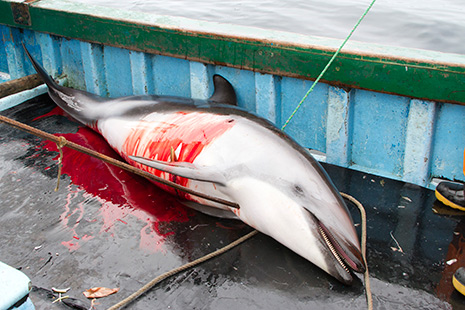Holocaust For Dolphins And Sharks In Peru

As many as 15,000 dolphins are killed yearly for use as shark bait and human consumption by Peruvian fishermen.
A BlueVoice/Mundo Azul expedition has returned with damning evidence of a massive hunt for dolphins carried out by Peruvian fishermen. This expedition follows an earlier expedition conducted by UK-based Ecostorm in collaboration with Mundo Azul.
BlueVoice provided full funding for the Mundo Azul expedition and partial funding for the Ecostorm effort.
Both expeditions brought back graphic video and photographic evidence of massive dolphin killing by Peruvian fishermen. Dolphins are harpooned, clubbed to death and then butchered to be used as shark bait. Dolphins are also killed for human consumption.
The president of Mundo Azul, Stefan Austermuhle who led the investigative expedition, reported "We videotaped from the boat and in the water and what we saw was unimaginably horrific. I just went numb looking at the pitiful dolphin being battered with a club. All I could do was continue recording the event in the hope that making the world aware of this tragedy can somehow bring an end to it."
Based on the size of the Peruvian fleet and interviews with the fishermen Austermuhle estimates as many as fifteen thousand dolphins are killed for bait and human consumption by the Peruvian fishing fleet in this manner. An unknown additional number are killed in the driftnet fishery.
Killing dolphins is illegal in Peru but the laws are difficult to enforce on the high seas. However, dolphin meat is sold in markets on shore and could be controlled at that point, if police were willing to do so.
"Blue sharks and Mako sharks were taken on board the Peruvian fishing vessel, whose name must remain confidential. The process involves unbelievable cruelty and can take can take as long as an hour."
Mako sharks, which are dangerous on deck, are cut behind the head to sever the spine. The fishermen cut the entire rostrum off the blue sharks.
"The shark meat is sold on the national market - The fins are separated in port by an intermediate fish dealer for export. BlueVoice and Mundo Azul will continue the investigation of markets into which the shark fins are sold."
In 2010, the Convention on Migratory Species (CMS) added the shortfin mako shark, one of the species taken off Peru, to Annex I (Migratory species threatened with extinction) of its Migratory Species listing. The vessel on which Austermuhle travelled fished primarily over a series of sea mounts where fish, including sharks aggregate. The sea mounts also attract dolphins due to the abundance of fish.
Though it is well known that Peruvian fishermen take hundreds of sharks, until now the world has been unaware of the vast slaughter of dolphins off Peru. Many are keenly aware of the dreadful killing of dolphins at Taiji, Japan and assume that is the largest slaughter of dolphins in the world; far from it. In fact, the killing of dolphins for food, called dolphin bush meat, is a worldwide problem and may be growing as traditional fisheries collapse.
When Stefan Austermuhle approached us with the horrifying information about the numbers of dolphins killed off Peru we were determined to provide the means for him to document these horrors. So BlueVoice funded expeditions to obtain proof of the slaughter. He spent three weeks aboard a sordid little fishing boat putting himself at grave personal risk. And he brought back the evidence we need to bust this tragic process.
BlueVoice, in collaboration with Mundo Azul and other conservation organizations will now bring this story to the media and to international councils and commissions.
We are entering into a worldwide campaign to end this barbarity.
